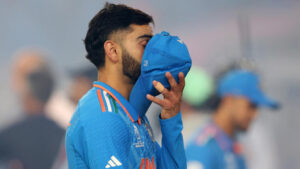NOVEMBER 19, 2023

Rohit Sharma looked like he was trying to hold back tears. Mohammed Siraj couldn’t. Jasprit Bumrah, who doesn’t let results sway his emotions, consoled him. KL Rahul sank to his knees. Virat Kohli hid his face in his cap. Mohammed Shami walked back dejected. The spirit had left them.
It hurts. The ones who will not play another World Cup will be hurting even more. The morning after will be even worse. It is good they have their families with them. There’s more to life than a World Cup. They will need that reinforced come Monday morning when there is no training to go to. The ones who don’t have families with them will need their team-mates to do the reinforcing for them.
That is the cruel nature of a league-knockout hybrid format. It will hurt India more than any team knocked out earlier in the tournament. That’s the price you pay: to fight for the biggest joy, you must risk the biggest heartbreak. It will hurt them more than it can hurt anyone on the outside.
All those runs and wickets will feel empty, just like the stands emptied by people who had already moved onto more mundane things like avoiding traffic jams. All the joy and the noise they had bathed in for a month-and-a-half suddenly gave way to a hollow hum. Rohit scored more runs than any captain ever has in one tournament. Kohli scored more than any batter ever has. Shami was the highest wicket-taker despite not playing four matches. These facts mean nothing to them in the moment.
However, in a cricket world with so much professionalism, with the top three sides having equal access to knowledge, facilities, technology and talent, it is still rare that you can beat the conditions. In the league match against Australia, India were on the right side of the conditions. In the final, they lost to the conditions.
An example of how much the pitch changed is how often Marnus Labuschagne dabbed the ball gently behind squares for singles; those easy singles hadn’t been available to India. The pitch had been so slow in the afternoon that there was risk involved in manipulating the bat face to pick up singles once the field spread out and the ball became old. Kohli was dismissed in exactly this manner, inside-edging Pat Cummins onto his stumps.
If Rohit’s words at the toss – he said he would have batted first had he won it – actually reflected the team management’s thoughts (sometimes a captain’s words can be just a front), it would be fair to say India misread the conditions. That didn’t matter because Australia won the toss, and they decided to play a different game.
India expected the pitch to keep getting slower and offer more turn, which happened in the Kolkata semi-final. They hoped they could capitalise on the brittleness of Australia’s chasing.
Australia went by recent trends in Ahmedabad. During this World Cup, batting has consistently become easier under the lights in Ahmedabad. They banked on the pattern continuing, and expected a drier-than-usual pitch to be at its most difficult in the afternoon. They wanted to exploit India’s relative weakness on slow pitches.
The second ball he faced from Josh Hazlewood, who had dismissed him in these teams’ league meeting, Rohit charged at him and crashed him through the covers for four. Rohit was playing the World Cup final like it should have been: just another game. All through the tournament, he had made it easy for India’s middle order by scoring quicker than anyone else in the powerplay.
It was even more important that Rohit did it here. Kohli got off to a great start too. Having seen Shubman Gill get out early, Kohli stuck to the team plan and ditched the risk-free game that had brought him 700-plus runs in the tournament. He took a risk off the ninth ball he faced, dragging Mitchell Starc over wide mid-on. It wasn’t a perfect shot, but Kohli knew he needed to take that chance during the powerplay.
With the ball, India had their early plans spot-on. They got Shami to open the bowling because of his superior numbers against left-hand batters. They would have been pleasantly surprised by the help Bumrah and Shami got but that zip and that movement came at a cost. In the evening, as it most noticeably happened for New Zealand against England in the tournament-opener, the pitch had quickened up, and the ball gripped much less.
Once Australia weathered the early storm, once the movement died down, only a genius delivery from Bumrah, a final reminder of the magic India have created through this tournament, got them a wicket, that of Steven Smith with a viciously dipping slower one. The rest of the story we have heard before in many a chase in India. Would India have won at the Wankhede 12 years ago had there been no dew?
There will of course be a review within the team. Perhaps Rahul could have been braver through the middle overs. Kohli has the game to keep scoring at the strike rate of 80 to 90 without having to hit boundaries. Kohli got a delivery that lifted on that slow pitch and got big on him. On another day the inside edge could have run past the leg stump. Not in this final.
Others have to take risks. It is no rocket science why Rahul didn’t take risks. India’s batting is shallow. I have asked the coaches on more than one occasion at press conferences how the batters have reacted to India not having any batting after No. 7. Particularly how their outlook to risk has changed. The coaches have maintained that they don’t even want to think about it because the top seven are good enough to do the job. It didn’t look like that at the Narendra Modi Stadium on Sunday.
They will look back at just the nine boundary attempts in 180 legal balls in the middle overs and wonder if that was sufficient. It meant India scored just four boundaries outside the powerplay, the joint-lowest in any ODI since 2005. On a slower pitch bowlers do have a larger margin for error, but only India can answer if they couldn’t have tried to push the bowlers off their lengths a little harder.
It is not like no batting lower down the order was a selection error. What Shardul Thakur brings at No. 8 is often notional. There is no reason to believe Siraj doesn’t offset that notional depth with what he brings with the ball as compared to Thakur. The problem is, none of India’s first-choice bowlers bat as well as even, say, Starc and Pat Cummins.
You might look back and say the India fast bowlers could have bowled more cutters, perhaps the spinners could have gone slower in the air to try to get the ball to turn because the pitch had something in it not too much earlier. They could have perhaps trusted Suryakumar Yadav more and not promoted Ravindra Jadeja to face a poor match-up against spin, as a result of which overs 30 to 36 featured no intent at all.
However, these are marginal issues. Had Rahul taken more risks, they might have come off but we also know the flip side of it. The players will not say it, but the change in the conditions from afternoon to evening was the biggest deciding factor. It doesn’t make them chokers or mentally less strong or less courageous. They have played so much cricket that they know they just have to roll with it.
And yet it will be the toughest thing for them to do. They have known this feeling before, but it never gets easier. And this time they came closer than ever since 2011. To fight for the biggest joy, you must risk the biggest heartbreak.
Courtesy: ESPN







































































































